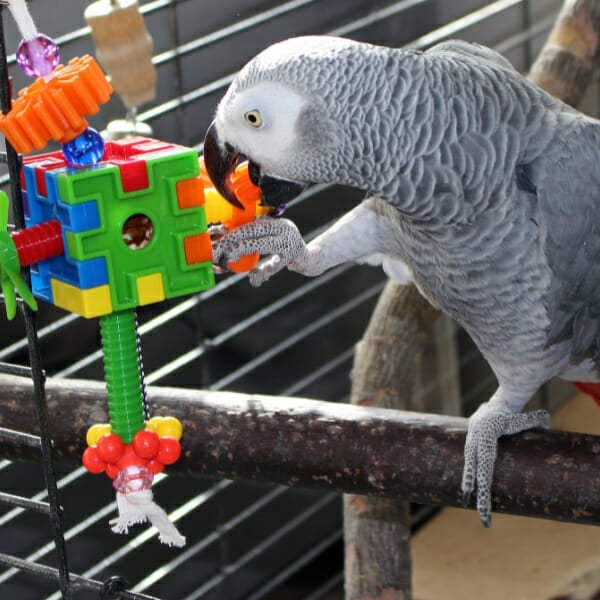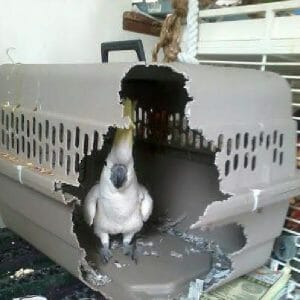Last Updated on by Mitch Rezman
We posted the picture above today on Facebook and one of our fans commented: “I sure hope this macaw doesn’t live in that tiny cage” my response may be a bit of a shock but I don’t necessarily have a problem with that.
The conventional wisdom is always been to get the largest bird cage you can afford for your parrot. Unfortunately, conventional wisdom is not always correct. The basic use for a birdcage is to keep the birds captive basically so it can’t get in trouble when unsupervised. But here’s the thing – the size of the cage should really be determined by the lifestyle that you develop with your bird(s).
I love to use the example of a customer of ours in the far southwestern suburbs of Chicago. Years ago I delivered a birdcage for her new Military Macaw. The drive was far and I didn’t get there till about 9:30 that night.
The customer’s husband helped me bring the two large boxes containing the new cage into the bird room. Turns out the Military Macaw was Macaw number seven for the family. There were two Hyacinths, a Greenwing, a Scarlet, 2 Blue and Gold Macaws all sharing the room with the new Military Macaw.
What was notable was that all of the birds were on top of or on play stands next to cages that looked very similar to the cage pictured above. The pristine antique cages were no more than 24 to 30 inches in diameter. The customer had kept the birds up until I got there and once we finished the transaction, I asked her about her philosophy regarding the relatively small cages for the very large birds. She just smiled and said, “watch this”.
She clapped her hands and said – just one time “okay bedtime for everybody” and the six large Macaws, without hesitation, all entered into their relatively small cages. The Hyacinths actually pulled their cage doors shut and she closed the other four doors with only the new Military now kind of rocking back and forth wondering what to do next on a stand.
Without missing a beat because she must have been reading my mind she went on to explain that she worked from home. She let the birds out of the cages by seven o’clock every morning and they were out until usually 8:00 or 8:30 every night so they were happy to climb into basically what were “sleeping cages”
She had some of these birds for more than 20 years and this was her lifestyle. You could tell these birds were well behaved, happy with wonderful feathers (no pluckers). The experience really changed our philosophy about housing birds.
Circling back to the theme of this blog post. If you’re gone 8 to 12 hours a day – work, school, and all the other places that life takes you we would like to see your bird in a walk-in aviary if could afford the space in your house. But if all your bird is doing is sleeping in his cage and is out all day that cage really doesn’t need to be all that big relative to the size of the bird.
We have many customers who have the birds in large cages in social areas of their homes. Social areas mean family members in the household may be up late watching television or conversing. If the bird remains in the social area and is kept up not allowed to sleep for 12 hours because of distractions until one or two o’clock in the morning, the situation can easily put a bird on the path of feather destruction or other nervous disorders.
Author Profile
Latest entries
 The Traveling BirdJune 26, 2025Can You Name 5 Parrot Species That Are Living Wild in the USA?
The Traveling BirdJune 26, 2025Can You Name 5 Parrot Species That Are Living Wild in the USA? Bird BehaviorJune 26, 2025How is it Parrots Are Problem Solvers Social Animals and Even Use Tools?
Bird BehaviorJune 26, 2025How is it Parrots Are Problem Solvers Social Animals and Even Use Tools? Bird & Parrot AnatomyJune 25, 2025How a Tiny Chemical Modification Makes Parrots Nature’s Living Paintings
Bird & Parrot AnatomyJune 25, 2025How a Tiny Chemical Modification Makes Parrots Nature’s Living Paintings PigeonsJune 20, 2025How Do Parrots Thrive in Cities Outside Their Native Habitats?
PigeonsJune 20, 2025How Do Parrots Thrive in Cities Outside Their Native Habitats?




